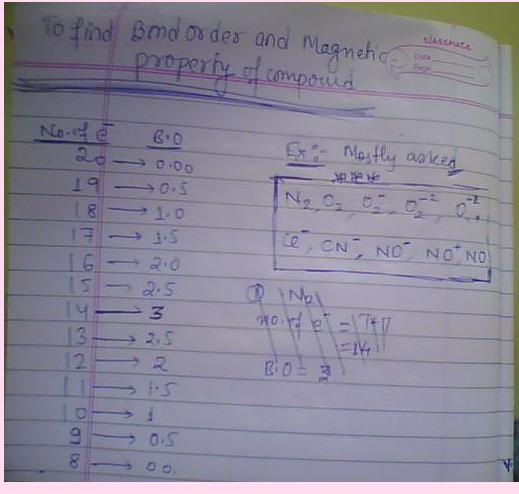 39
39Well for our syllabus, apart from NO- and O2, all molecules with integral bond orders are diamagnetic (the exceptions I mentioned are paramagnetic due to Hund's rule which causes singlet occupation in 2p orbitals). The ones having fractional bond order are paramagnetic. This is a rough rule which works within the scope of our syllabus.
To find bond order, there is a nice quickie method my friend told me. Msg me in my chatbox and I'll tell you.
 29
29Well as far as i know the shortcut comes from practice
@Pritish
Share ur knowledge here in the thread that will be better..
 21
21 i found out this on one of the discussions here on tiit.
i found out this on one of the discussions here on tiit.
 21
21pritish is this the shortcut you were talking abt or something else?
 39
39Well since it's being demanded so much....here it is. It requires a little knowledge of the periodic table.
Steps to find the bond order -:
1. If the element is in a group number less than 8, then subtract 8 from its group number. For eg, nitrogen = 7, oxygen = 8, fluorine = 9, etc.
2. Add up such numbers from each of the constituent atoms. For eg, for N2, 7 + 7 = 14.
3. Subtract 8 again.
4. After this subtraction, with the number you have left, you put 6(REQUIRED at all costs...if you have a number smaller than 6 after subtraction, put all you have) into the bonding orbital. After putting minimum 6 into bonding orbital, put the rest into antibonding orbital.
5. Now you can easily find bond order.
Let's do this by example. How about N2?
1. 15 - 8 = 7.
2. For two N atoms, 7 + 7 = 14.
3. 14 - 8 = 6.
4. NB = 6, NA = 0 [These are not the actual figures of electrons in those orbitals. Just for the formula]
5. BO = 1/2(6 - 0) = 3 which is indeed so! N2's triple bond shows here.
 1
1gud one..u can use this also......
count the number electron in outermost orbit in the atoms...
add em up
let it be n
if n=10 ....BO=3
n=11... BO=2.5
and the BO decreases by 0.5 for each successive electron added
similarly for backwards...
n=9....BO=2.5
n=8....BO=2......n so on
Eg....
for oxygen...6 electron in outermost
so n=12....BO =2
for NO....outermost electrons...n=5+6=11
so bond order 2.5
 i found out this on one of the discussions here on tiit.
i found out this on one of the discussions here on tiit.